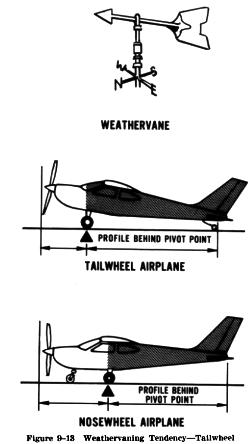When an airplane is airborne it moves with the air mass in which it is flying regardless of the airplane's heading and speed. However, when an airplane is on the ground it is unable to move with the air mass (crosswind) because of the resistance created by ground friction on the wheels.
Characteristically, an airplane has a greater profile or side area, behind the main landing gear than forward of it (Fig. 9-13). With the main wheels acting as a pivot point and the greater surface area exposed to the crosswind behind that pivot point, the airplane will tend to turn or "weathervane" into the wind.
Though it is characteristic of most airplanes, this weathervaning tendency is more prevalent in the tailwheel type because the airplane's surface area behind the main landing gear is greater than in nosewheel type airplanes.
Wind acting on an airplane during crosswind landings is the result of two factors - one is the natural wind which acts in the direction the air mass is traveling, while the other is induced by the movement of the airplane and acts parallel to the direction of movement. Consequently, a crosswind has a headwind component acting along the airplane's ground track and a

